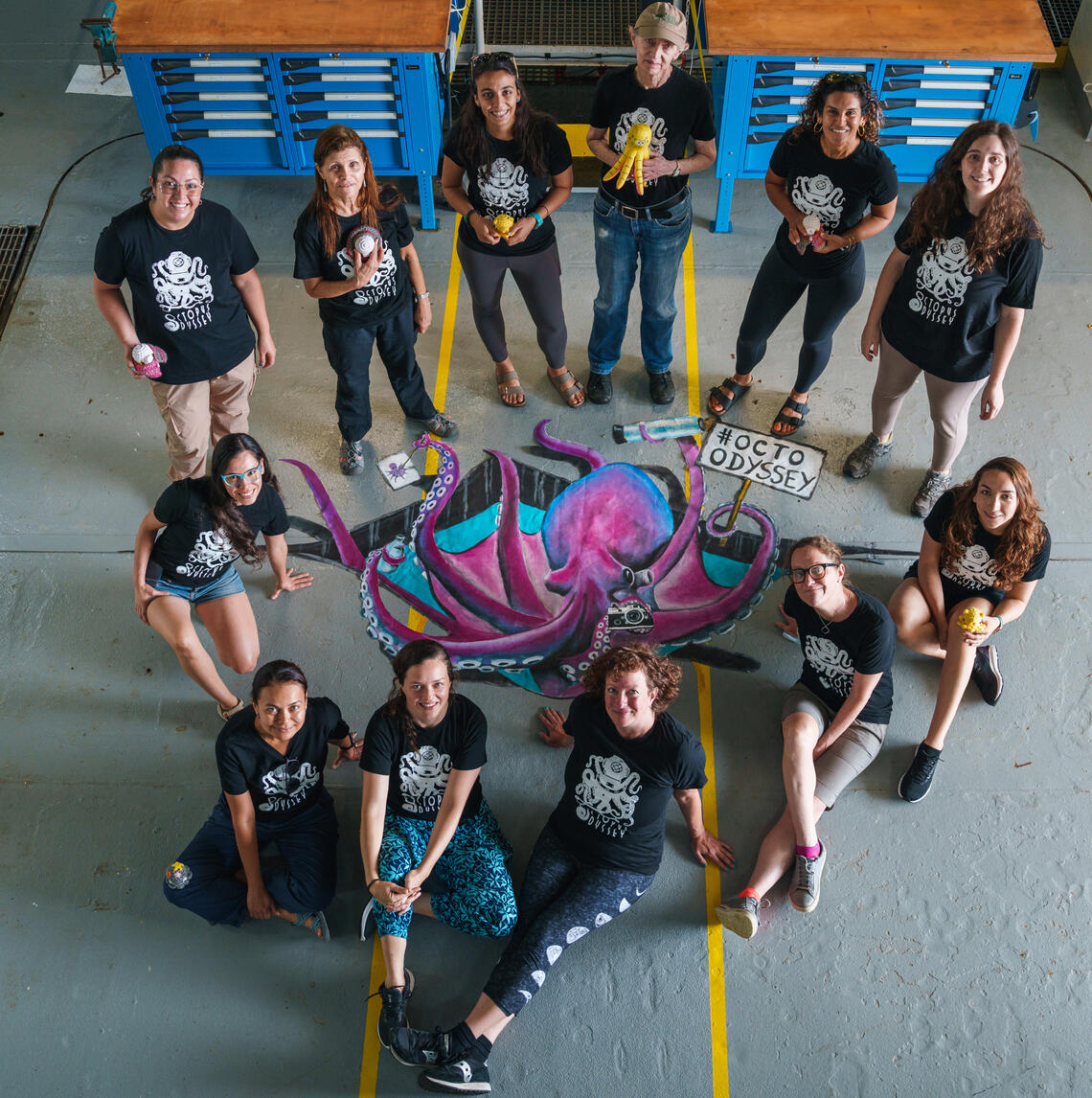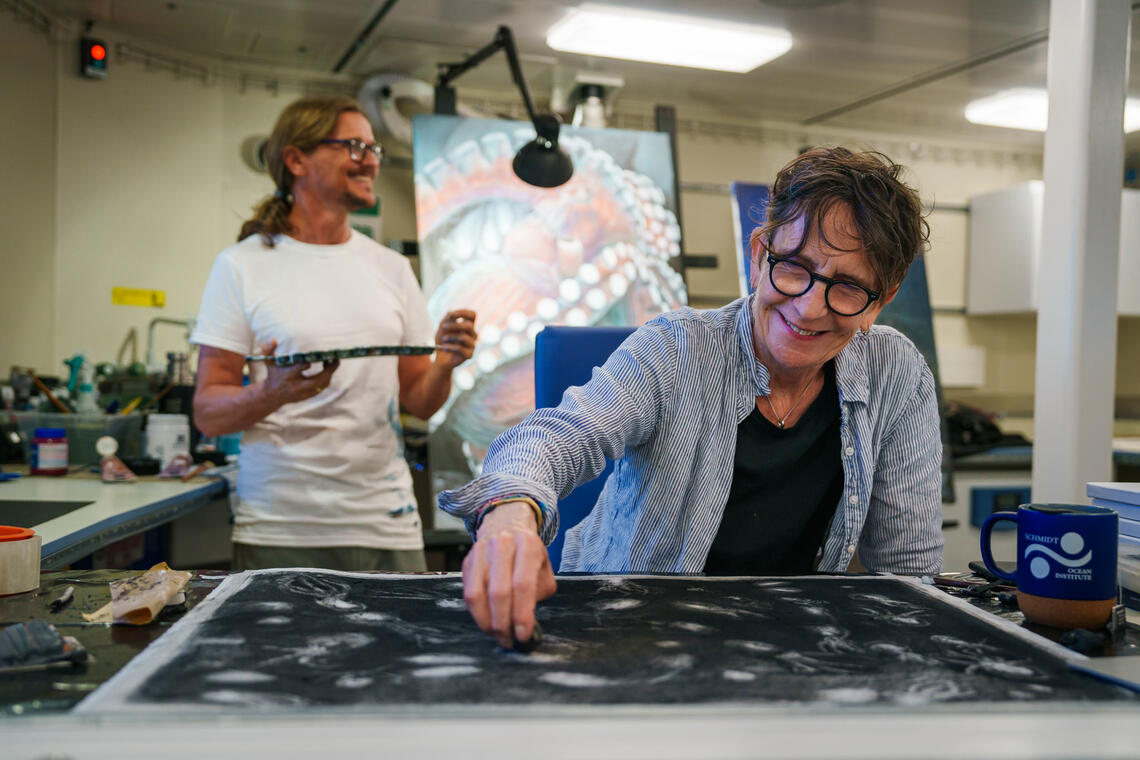Aug. 9, 2023
Deep ocean expedition leaves UCalgary scientist awestruck

Dr. Rachel Lauer, PhD, knows that what happened on the Octopus Odyssey may never happen to her again. She’s not talking about watching baby octopuses hatch in a rare nursery in the depths of the Costa Rican Ocean, though that was an experience that kept her awake for days on end, entranced by the pure wonder of the natural world.
She’s talking about being part of a group of people on the research vessel for over three weeks, a group that worked so perfectly together Lauer could only describe it as “intoxicating.”
“We were all so inspired by what everyone else was doing. Everyone wanted to learn. I’ve never had an experience like it and probably won’t again,” she said.

The Octopus Odyssey consisted of over 70 per cent women.
Alex Ingle, Schmidt Ocean Institute
With scientists, policymakers and artists on board, the expedition was a collaboration of great minds with one thing in common: a love for deep-sea research. Over half of the crew were Costa Rican, and over 70 percent were women. Considering that before the mid-1960s women scientists weren’t even allowed on research vessels, having a crew of mostly women on the Octopus Odyssey was a rare experience that Lauer knows is nothing short of groundbreaking.
A serendiptious discovery
Lauer will be the first to admit it: she’s a hydrogeologist, not a biologist. When she went on her first trip to the Dorado Outcrop—an outcrop of rock offshore Costa Rica at a depth of 3,000 meters—she and her team were trying to find samples of pristine fluids coming out of hydrothermal vents from the earth’s crust. The region around Dorado Outcrop is missing over 70 percent of its heat and Lauer was trying to figure out why.
“We were looking for a geyser of hot water. Instead, we found a ton of octopuses,” said Lauer. “We stumbled on them serendipitously.”
The next year, the crew went back, but this time with the Alvin: a crewed deep-ocean research submersible. The trip to the bottom of the ocean took two hours. Lauer and the research crew then spent five hours on the ocean floor and another two hours ascending.
“Just a regular workday,” Lauer joked.
“The footage from those dives was published in a paper and seen by a biologist who was like, brooding octopuses aren’t supposed to be there. They are solitary creatures who don’t like warm water. What are they doing there?”
Soon, several articles were published in scientific journals with a truly bleak hypothesis: the area was inhospitable for developing octopus young, and the nursery had no chance of survival.
A learning curve
Lauer had been on many research expeditions prior to the Octopus Odyssey: an expedition to figure out if the octopus nursery was indeed active or if the hypothesis was correct. Still, much of the expedition was a learning curve. As a hydrogeologist on a largely biology-focused mission, she had to be comfortable with vulnerability. For example, the entire crew had to take shifts on the intercom where they commented on what they were seeing. The ship was full of screens displaying 4K live feed video footage from the ocean floor. To Lauer, it felt like being in a National Geographic movie, 24/7.
“It was hilarious because everyone knew my PhD student and I were the two people on the vessel who were not biologists.”
When she saw a species that she didn’t recognize, a biologist would hand her a sticky note and whisper to her exactly what to announce over the intercom. What they saw was nothing short of astonishing—everything from the bizarre and beautiful tripod fish to corals over 15,000 years old.
Lauer learned a lot from her roommate, as well, a biologist from Trinidad and Tobago who studies the intersection of policy and deep marine biology. She and Lauer would discuss the potential consequences of deep-sea mining in their room for hours.
“We’ve only mapped five percent of the deep ocean,” said Lauer. “We have mapped our moon and mars at a higher resolution than we have our own sea floor.”

The two artists hard at work aboard the Falkor (too).
Alex Ingle, Schmidt Ocean Institute
There were also two artists on board. They not only worked on their paintings but helped the scientists with tasks like water sampling. The Schmidt Ocean institute, who sponsored the expedition and provided the research vessel, the Falkor (too), believes that working across disciplines is the key to research excellence.
“The artists were directly involved with all the science, asking questions and trying to understand what they were seeing. It was so fascinating,” said Lauer.
The baby hatches
Witnessing the first octopus baby hatch was an emotional experience—an experience made even more powerful because it was shared amongst the group aboard the Falkor (too).
“Everyone was screaming and crying because it was a ship full of very amazing women,” said Lauer.
Witnessing the eggs hatch meant the earlier hypothesis was completely wrong. It meant the team had discovered an active octopus nursery—one of four nurseries in the world.
“A couple of days later my partner was on the phone, and he was like, Rachel, if you don’t start sleeping, you’re going to burn out. I wasn’t manic, but like, almost? I just didn’t want to miss anything.”

The Falkor (too) research vessel housed scientist, policy experts and artists for 23 days earlier this year.
Alex Ingle, Schmidt Ocean Institute
Obsessed with biology
Being aboard the Octopus Odyssey reinforced Lauer’s belief that working across disciplines is crucial to advancing science. She knows that one thing that differentiates scientists now from scientists 30 years ago is collaboration.
“Before, you got the PhD, the post-doc, and you kept digging down in the same hole. Your goal was to just keep knowing more about that thing and remaining on a linear trajectory. That has just never appealed to me, mostly because my work is so data poor that I have to collaborate with other people, I can’t solve these problems on my own,” she said.
“Science. Policy. Art. These things should all be seamlessly working together. You shouldn’t be doing science in a vacuum. You shouldn’t be doing science in a silo.”
Lauer admits that she is now “obsessed” with biology. She wants to get involved in UCalgary’s Bamfield Marine Sciences Centre and audit a marine biology class on campus. She also wants to become a delegate for Canada for the International Seabed Authority so she can represent expertise on deep ocean processes that are directly affected by deep sea mining.
It was on the plane ride home that she and her PhD student looked at each other and agreed: they needed to keep doing this kind of work. Sure, investigating the original heat flow problem in the Dorado Outcrop was interesting, but joining forces with an incredible group of women and crossing disciplines into biology, conservation, policy and even art—that’s more than interesting. That’s emotional. That’s urgent. That’s exactly where Lauer wants to be.
Dr. Rachel Lauer is an associate professor in the department of Geoscience. She was one of 18 international scientists aboard the Falkor (too) for the Octopus Odyssey.
The Schmidt Ocean Institute is a non-profit organization dedicated to advancing oceanographic research, discovery, and knowledge, and catalyzing sharing of information about the oceans.







